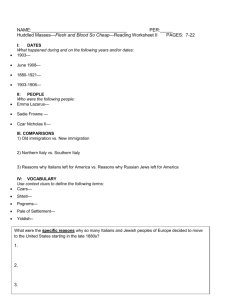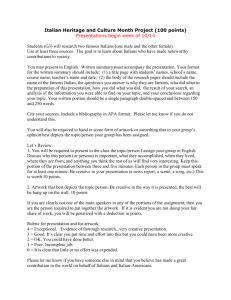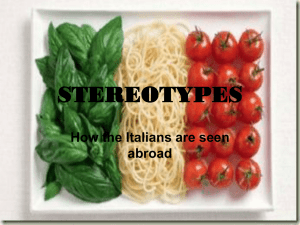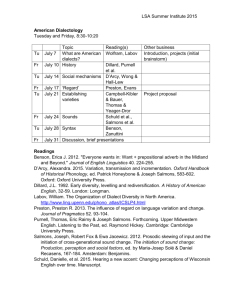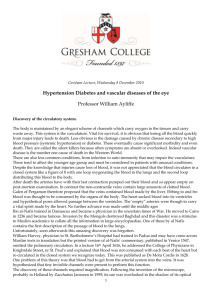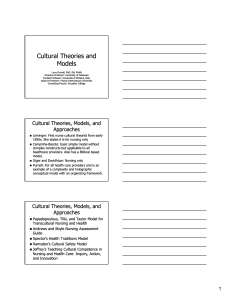Research Paper
advertisement
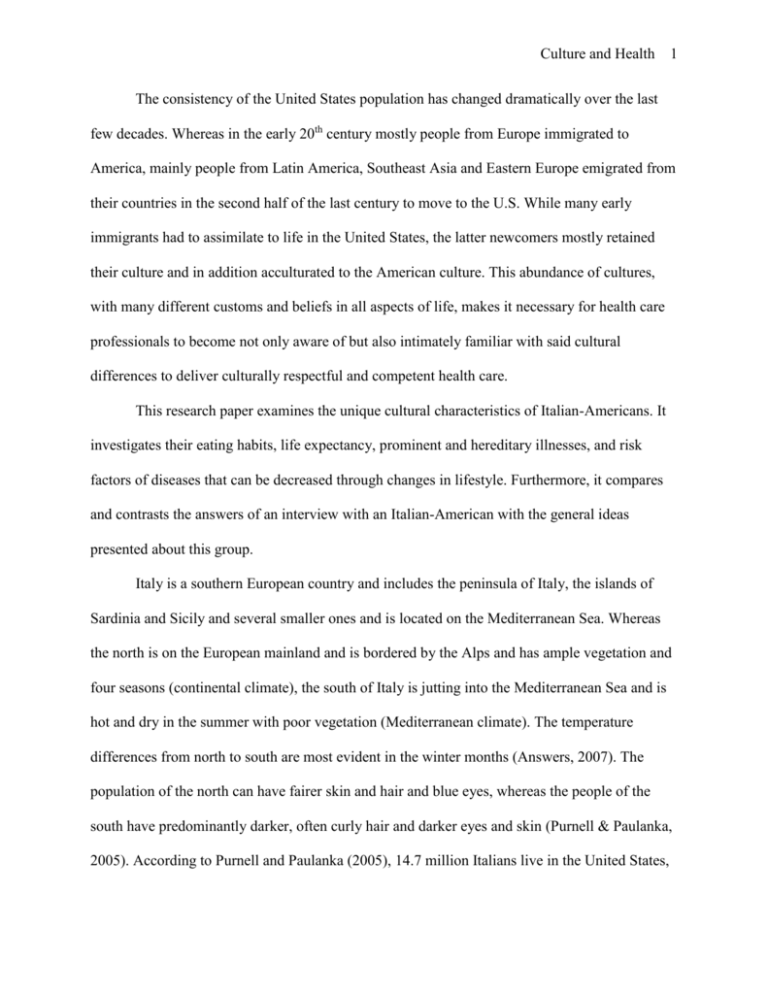
Culture and Health 1 The consistency of the United States population has changed dramatically over the last few decades. Whereas in the early 20th century mostly people from Europe immigrated to America, mainly people from Latin America, Southeast Asia and Eastern Europe emigrated from their countries in the second half of the last century to move to the U.S. While many early immigrants had to assimilate to life in the United States, the latter newcomers mostly retained their culture and in addition acculturated to the American culture. This abundance of cultures, with many different customs and beliefs in all aspects of life, makes it necessary for health care professionals to become not only aware of but also intimately familiar with said cultural differences to deliver culturally respectful and competent health care. This research paper examines the unique cultural characteristics of Italian-Americans. It investigates their eating habits, life expectancy, prominent and hereditary illnesses, and risk factors of diseases that can be decreased through changes in lifestyle. Furthermore, it compares and contrasts the answers of an interview with an Italian-American with the general ideas presented about this group. Italy is a southern European country and includes the peninsula of Italy, the islands of Sardinia and Sicily and several smaller ones and is located on the Mediterranean Sea. Whereas the north is on the European mainland and is bordered by the Alps and has ample vegetation and four seasons (continental climate), the south of Italy is jutting into the Mediterranean Sea and is hot and dry in the summer with poor vegetation (Mediterranean climate). The temperature differences from north to south are most evident in the winter months (Answers, 2007). The population of the north can have fairer skin and hair and blue eyes, whereas the people of the south have predominantly darker, often curly hair and darker eyes and skin (Purnell & Paulanka, 2005). According to Purnell and Paulanka (2005), 14.7 million Italians live in the United States, Culture and Health 2 predominantly in the northeastern states of Massachusetts, New Jersey, New York and Pennsylvania, and in California. However, there are Italian enclaves in many major cities in other parts of America. The average life expectancy of Italians in general is 79.68 years, with men living on average 76.75 years and women living longer with 82.81 years, according to the World Fact Book 2005, prepared by the Central Intelligence Agency. The eating habits of Italian-Americans vary with the region were they originated from. Italians from the north use mostly cream and cheese based sauces and a lot of butter, which could lead to an increased intake of fat, whereas people from the south prepare tomato based pasta sauces, with spices, extra salt and use plenty of olive oil. In general, the Italian diet consists of vegetables, pasta, fruit, fish and cheese (Purnell & Paulanka, 2005). Italians drink wine with almost every meal and even allow their children to drink red wine mixed with water during meals to maintain healthy blood, as stated by Purnell and Paulanka (2005). Health care practices involving food include “eating a clove of garlic every night before going to bed to prevent upper respiratory infections” (Purnell & Paulanka, 2005). Garlic is also worn around the neck in times of flu epidemics to prevent infection. Consuming a fresh raw egg every morning keeps one strong and eating fresh dandelions in salads or soups helps a person regain his or her strength (Purnell & Paulanka, 2005). Moreover, Italians enjoy talking loudly and with passion, conveying their emotions to their conversation partner. This does not necessarily mean that they are angry at each other. During conversations, Italians frequently use non-verbal communication, e.g. touching each other, to show their affection and kiss each other on the cheek upon greeting. They furthermore use grand gestures while talking to make a point (Purnell & Paulanka, 2005). Culture and Health 3 According to Purnell and Paulanka (2005), Italian women make decisions regarding the economical situation of the family and the running of the household, since their husbands turn over their paycheck to them. The mothers are also primarily responsible for the upbringing of their children. From the children is expected to be well behaved and to respect their elders. Also, they should contribute to chores in the household and “support the family as soon as they are old enough to work” (Purnell and Paulanka, 2005). Purnell and Paulanka (2005) found that the different generations of Italian families like to stay close to each other and frequently visit their parents or grandparents for big family meals. Spirituality is very important to Italians and in time of illness, prayers from family members to cure the ill are common, as well as having faith and praying helps the ill to get through the illness. Although, most Italians are roman-catholic and are obligated to fast during lent and are not allowed to eat meat on Fridays, the ill do not have to follow these obligations (Purnell & Paulanka, 2005). Regarding health care practices of Italians, Purnell and Paulanka (2005) write that Italians consider a disease or illness as god’s will and that it will run its course. Therefore, it is often ignored until the health problem become too serious. Italians like to protect themselves from negative influences, e.g. the evil eye and the eye of death, by wearing amulets and practicing witchcraft. Because of the high cost of health care, many Italians are reluctant to seek medical care and have little faith in medical professionals. If the physician is Italian, they are more inclined to follow his or her recommendations (Purnell & Paulanka, 2005). Due to a high carbohydrate and fat diet, Italian-Americans suffer from prominent illnesses like diabetes and cardiovascular disease related to smoking and type A behavior. High-risk behaviors include smoking and alcoholism (Purnell & Paulanka, 2005). A study published in the Culture and Health 4 Annals of Internal Medicine by Beulens, Rimm, Ascherio, Spiegelman, Hendriks, and Mukamal (2007) found that alcohol consumption among men with hypertension is a risk factor for coronary artery disease. A number of hereditary illnesses are common among Italian-Americans. One of them is Familial Mediterranean Fever, also called familial paroxysmal polyserositis, which “is characterized by short attacks of fever,” (Purnell & Paulanka, 2005) inflammation of the serous membrane lining the cavity of the abdomen and covering the abdominal organs, pleurisy and arthritis. If not treated, death may be caused by amyloidosis, a disorder marked by deposition of a starch like protein in the liver, kidney, spleen or other tissues (Purnell & Paulanka, 2005). Purnell and Paulanka (2005) found that there “is no specific diagnostic test available” and that “treatment is symptomatic.” Furthermore, another genetically passed on illness of people of Italian descent is Mediterranean type glucose-6-phosphate dehydrogenase (G6PD) deficiency. According to Purnell and Paulanka (2005) it is a disorder linked to the X-chromosome and mostly found in men with two identical dominant genes coding for the disease, although it is also present in heterozygous women in a carrier state. G6PD deficiency can lead to red blood cell damage during extended treatment with medications like sulfonamides, i.e. synthetic drugs that are able to prevent the multiplication of some pathogenic bacteria, antimalarial agents, salicylates, e.g. Aspirin, and naphthaquinolones. Similarly, hemolysis can also arise in the company of abnormally low concentration of oxygen in the blood or acidosis as well as after eating fava beans (Purnell & Paulanka, 2005). To revert the effects of erythrocyte damage, Purnell and Paulanka (2005) assert to simply remove the etiologic agent, give blood transfusions and iron orally, which should lead to voluntary recovery. Culture and Health 5 Moreover, Beta-Thalassemia is an additional inherited disease among Italian-Americans that “is caused by a genetic defect in the synthesis of the hemoglobin A or B chain” (Purnell & Paulanka, 2005). In Beta-Thalassemia minor, B chain synthesis is somewhat impaired leading to mild or moderate anemia, abnormal enlargement of the spleen, the skin turning to a bronze color, “and hyperplasia of the bone marrow,” (Purnell & Paulanka, 2005) whereas B chain production in Beta-Thalassemia major, or Cooley’s anemia, is seriously reduced, causing severe anemia and death in early childhood by heart failure if not treated. Although there is no cure, relieving the pain is possible by frequently transfusing packed red blood cells (Purnell & Paulanka, 2005). Just as G6PD deficiency, Beta-Thalassemia has a serious effect on drug metabolism and administering above-mentioned medications is strongly advised against (Purnell & Paulanka, 2005). Further prominent hereditary illnesses include high blood pressure. Some of the prevalent diseases and illnesses of Italian-Americans have risk factors that can be decreased through lifestyle changes. Cardiovascular disease related to a sedentary lifestyle can be prevented through regular exercise. According to Potter and Perry (2005) the positive effects of exercise are “increased cardiac output, improved myocardial contraction, thereby strengthening cardiac muscle, decreased resting heart rate and improved venous return.” The risk factors of excessive alcohol consumption and smoking leading to cardiovascular and pulmonary disease should be eliminated. Changing the diet can reduce the risk of developing cardiovascular disease. Decreasing the amount of kilocalories, sodium, fat, soft-textured foods, and cholesterol according to the American Heart Association guidelines will help prevent coronary artery disease. The intake of magnesium, folic acid, and vitamin B6 seem to help with preventing the primary development of cardiovascular disease (Potter & Perry, 2005). Culture and Health 6 Moreover, exercise is also very important to reduce high systolic and diastolic blood pressure. Potter and Perry (2005) note that “low- to moderate-intensity aerobic exercise (brisk walking, bicycling) appears to be the most effective in lowering blood pressure.” Dietary changes to help reduce the risk for hypertension consist of reducing the amount of kilocalories to promote weight loss and lowering the amount of sodium and fat consumption (Potter & Perry, 2005) Furthermore, stress management, e.g. stress reducing techniques, quitting cigarette smoking and discontinuing heavy alcohol consumption help lower blood pressure. Diabetes is another disease that can be controlled with exercise, in addition to diet, glucose monitoring and medications. According to Potter and Perry (2005), “individuals with type 1 diabetes are encouraged to exercise because it leads to improved cardiovascular fitness and psychological well-being.” People with type 1 diabetes should make sure to check their blood glucose level before and after a low- to moderate-level workout. Furthermore, they should not inject insulin into the muscle that is being exercised, make sure to bring a source of carbohydrates and wear a medical alert bracelet. Similarly, persons with type 2 diabetes should include a warm up and cool down period in their low-level workout and exercise 3 days a week for 20-45 minutes (Potter & Perry, 2005). Whereas type 1 diabetes has to be controlled by insulin and dietary restrictions, type 2 diabetes may be controlled at first exclusively by exercise and dietary changes. Later on oral medications may need to be added and if exercise and diet changes are not effective, insulin injections are required (Potter & Perry, 2005). Dietary changes, as noted by Potter and Perry (2005), include: “Fats are moderately controlled (30% or less), and complex carbohydrates make up the majority (50% to 60%) of the diet, rather than simple carbohydrates. Protein comprises Culture and Health 7 10% to 20% of daily intake. Foods that contain soluble fiber are recommended, with a daily intake of 40 g of fiber.” For the purposes of this paper, I conducted an interview with my friend E. R., a third-generation Italian-American, who is currently living in Miami Beach, Florida, but lived for many years in the New York City area. Contrary to Purnell and Paulanka (2005), who state that “many second-generation Italian-Americans do not speak Italian well or at all,” E. R. and his parents speak Italian fluently. My interviewee also stated that he is usually on time for appointments and for social engagements, confirming Purnell and Paulanka’s (2005) statement about punctuality of second and third-generation Italians. Furthermore, Purnell and Paulanka (2005) claim that in most Italian-American families the man is the head of the household and no major purchase or decision is made without his consent, whereas in E. R.’s family the entire family makes those decisions together. E. R. is gay and his family is accepting his sexual orientation, which is in agreement with what Purnell and Paulanka (2005) write about Italian-Americans. Regarding questions about biocultural ecology, E. R. provided answers indicating no allergic reactions or problems associated with over-the-counter medications and no major illnesses and/or genetic diseases in his family. Only when taking prescription medications, E. R. is experiencing heartburn. My interviewee does not engage in any high-risk health behaviors, e.g. smoking and recreational drug use, and uses condoms during sex and does not have sex with drug users. Confirming Purnell and Paulanka’s claim that Italians drink wine with every meal, E. R. stated that he drinks one glass of red wine with dinner on average per day. Since E. R. is not satisfied with his weight, and he consumes a lot of carbohydrates, like bread and pasta, every day, he tries to balance his diet with fish, fruit and vegetables. To maintain his health E. R. is eating fruits and steamed vegetables and avoids foods like sugar and animal fat. Culture and Health 8 He only eats twice a day, but snacks in between meals on pastries, something that gives him heartburn. No other food allergies were mentioned. Although E. R. does not practice a form of organized religion, he considers himself deeply religious and spiritual, prays two times a day and considers faith as a source of strength and to give meaning to his life. In correlation with Purnell and Paulanka’s (2005) views on how Italians deal with health-care issues, E. R. is very responsible in his health-care practices. He walks every day and gets regular check-ups by a doctor. Acupuncture is another health-care practice E. R. uses. His family has access to primary care and practices health promotion “through personal hygiene, good nutrition, clean living environments, regular exercise, rest, and the adoption of positive health attitudes” (Potter & Perry, 2005). Furthermore, E. R.’s family has access to and utilizes secondary and tertiary care, i.e. acute care, like emergency treatment or critical care, and special care, as evidenced by the death of E. R.’s brother from long-term cancer. My interviewee’s family places a great deal of importance on Western medicine, regularly visiting health care professionals for screenings and only uses herbal teas for the common cold as alternative and complimentary medicine. When studying the family tree, I can identify certain trends regarding illnesses and diseases in E. R.’s family. His family does not suffer from any of the hereditary illnesses and diseases, i.e. Familial Mediterranean Fever, Mediterranean type G6PD deficiency, and/or Beta-Thalassemia, with the exception of hypertension. High blood pressure is common in both sides of his family. Furthermore, the death of E. R.’s brother from long-term cancer does not fit any trend in his family, since there is no previous history of cancer in the family and no other family member has cancer as of the time of this interview. However, there is a history of diabetes on his mother’s side and his sister is also suffering from diabetes. Culture and Health 9 Culture has an enormous impact on health and illness. When considering the example of Italian-Americans, their health and illness are influenced by a number of factors. Because Italy is located on the Mediterranean Sea, Italian-Americans can suffer from genetically passed on diseases and illnesses, like Familial Mediterranean Fever, Mediterranean type G6PD deficiency, and Beta-Thalassemia, diseases only affecting people from countries around the Mediterranean Sea. Although Italians consume a lot of healthy foods, like fresh olive oil, spices and vegetables, they also eat many empty calories in carbohydrates, like pasta and bread, and in fatty foods, like cream sauces and cheese, leading to weight problems, cardiovascular disease, hypertension and diabetes. Many Italian-American immigrants still smoke, adding to their health problems pulmonary disease and lung cancer. Smoking is also considered a risk factor for cardiovascular disease and diabetes. Although a glass of red wine a day can have positive effects on health, drinking alcohol excessively can lead to alcoholism which is considered a risk factor among men with hypertension for coronary artery disease. Moreover, Italian-Americans’ health-care practices can have a huge impact on their health. Since Italians believe in fatalism, they accept that a disease is a punishment from god and let it run its course until it is possibly too late to cure the ill. The fact that Italians are mistrusting of health care workers that are not Italian or do not make an effort to understand their culture, can lead to ignoring their instructions regarding taking medications or discontinuing practices that are harmful to their health. However, most Italian-Americans are very religious and spiritual and they pray for themselves when they are sick and for others who are ill. This positive attitude can lead to improvement in times of illness. Furthermore, Italians like to use religious amulets to protect them from negative influences, which can give them a great deal of comfort. Culture and Health 10 Family Tree P. R. Male 86 Married Deceased Hypertension G. F. Female 84 Married Deceased Hypertension P. R. Male 66 Married Alive Hypertension E. R. Male 45 Divorced Alive Hypertension E. R. Female 44 Single Alive Diabetes A. P. Male 84 Married Alive Hypertension T. A. Female 83 Married Deceased Diabetes E. R. Male 40 Married Deceased Cancer E. R. Male 30 Married Alive Hyperte I. P. Female 63 Married Alive Hypertension Diabetes E. R. Male 43 Single Alive Heartburn Culture and Health 11
